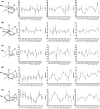Pre-organized structure of viral DNA at the binding-processing site of HIV-1 integrase
- PMID: 15814814
- PMCID: PMC1074723
- DOI: 10.1093/nar/gki346
Pre-organized structure of viral DNA at the binding-processing site of HIV-1 integrase
Abstract
The integration of the human immunodeficiency virus type 1 DNA into the host cell genome is catalysed by the viral integrase (IN). The reaction consists of a 3'-processing [dinucleotide released from each 3' end of the viral long terminal repeat (LTR)] followed by a strand transfer (insertion of the viral genome into the human chromosome). A 17 base pair oligonucleotide d(GGAAAATCTCTAGCAGT), d(ACTGCTAGAGATTTTCC) reproducing the U5-LTR extremity of viral DNA that contains the IN attachment site was analysed by NMR using the classical NOEs and scalar coupling constants in conjunction with a small set of residual dipolar coupling constants (RDCs) measured at the 13C/15N natural abundance. The combination of these two types of parameters in calculations significantly improved the DNA structure determination. The well-known features of A-tracts were clearly identified by RDCs in the first part of the molecule. The binding/cleavage site at the viral DNA end is distinguishable by a loss of regular base stacking and a distorted minor groove that can aid its specific recognition by IN.
Figures





References
-
- Hazuda D.J., Felock P., Witmer M., Wolfe A., Stillmock K., Grobler J.A., Espeseth A., Gabryelski L., Schleif W., Blau C., Miller M.D. Inhibitors of strand transfer that prevent integration and inhibit HIV-1 replication in cells. Science. 2000;287:646–650. - PubMed
-
- Pommier Y., Neamati N. Inhibitors of human immunodeficiency virus integrase. Adv. Virus Res. 1999;52:427–458. - PubMed
-
- Esposito D., Craigie R. HIV integrase structure and function. Adv. Virus Res. 1999;52:319–333. - PubMed
-
- Katzman M., Katz R.A. Substrate recognition by retroviral integrases. Adv. Virus Res. 1999;52:371–395. - PubMed
-
- Gerton J.L., Brown P.O. The core domain of HIV-1 integrase recognizes key features of its DNA substrates. J. Biol. Chem. 1997;272:25809–25815. - PubMed

